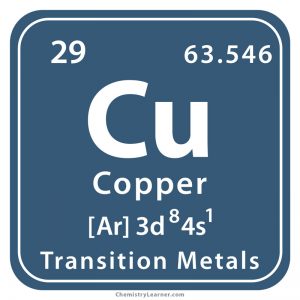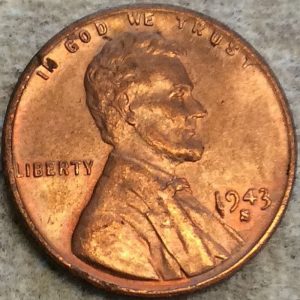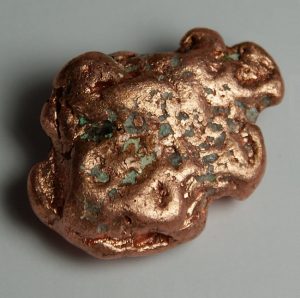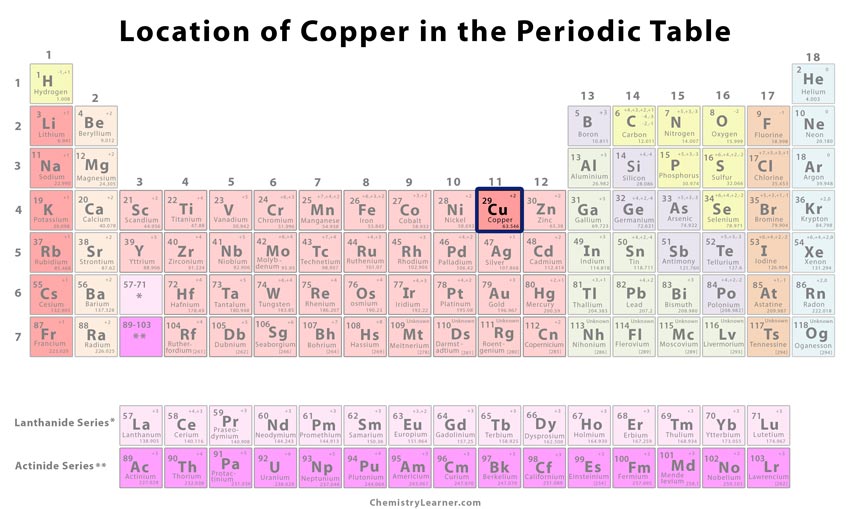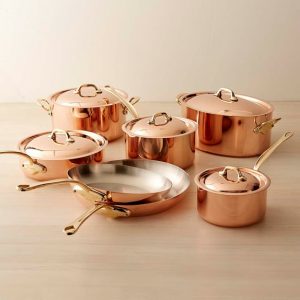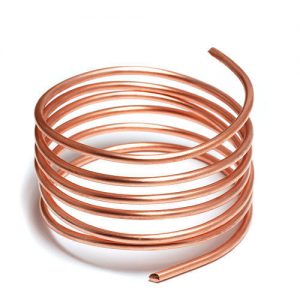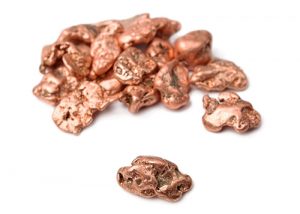Copper
What is Copper
Copper (pronunciation KOP-er [2]), represented by the chemical symbol or formula Cu [1], is a soft, malleable and ductile element belonging to the family of transition metals [3, 4, 7]. Naturally, occurring Cu is a mixture of 2 stable isotopes with mass numbers 63 and 65 [1, 3]. Besides that, it has 24 synthetic, radioactive isotopes with known half-lives [3]. Under normal conditions, it is stable in air, but in red-hot condition, it reacts with oxygen to form its oxide. It also reacts with halogens and acids [21].
Where Is It Found
The metal rarely occurs freely in nature. Its principal ores are minerals such as bornite and chalcopyrite. Cu is isolated from these ores by smelting, leaching and electrolysis [1, 3].
History
Origin of Its Name: The name is derived from its old English name ‘coper’ that is in turn derived from the Latin words ‘Cyprium aes’ that means a metal from Cyprus [1].
Who Discovered Copper: Unknown [1].
When Was It Discovered: In prehistoric times [1].
How Was It Discovered
Historically, Cu was the first metal to be worked by humans. The discovery that it could be hardened by the addition of tin to form the alloy bronze led to the naming of the Bronze Age when it was used in making coins, cutlery and tools. Copper beads excavated from northern Iraq were found to be more than ten thousand years old [1].
Copper Identification |
|||
| Atomic Number | 29 [1] | ||
| CAS Number | 7440-50-8 [1] | ||
| Position in the periodic table | Group | Period | Block |
| 11 [1] | 4 [1] | d [1] | |
Properties and Characteristics of Copper
General Properties |
||
| Atomic mass | 63.546 atomic mass units [1] | |
| Atomic weight | 63.546 [1] | |
| Mass number | 63 [3] | |
| Molar mass/molecular weight | 63.546 g/mol [20] | |
Physical Properties |
||
| Color/appearance | Orange-red [3] | |
| Luster | Bright metallic [3] | |
| Melting point/freezing point | 1084.62°C, 1984.32°F [1] | |
| Boiling point | 2560°C, 4640°F [1] | |
| Density | 8.96 g cm-3 [1] | |
| State of matter at room temperature (normal phase) | Solid [1] | |
| Thermal Conductivity | 385 W/(m K) [8] | |
| Electrical Conductivity | 5.96X107S/m [9] | |
| Specific heat capacity | 0.385 J/g oC [10] | |
| Specific gravity | 8.89 [11] | |
| Resistivity | 1.72X10-8 ohm-m [12] | |
| Hardness (Mohs scale) | 3 [13] | |
| Yield strength | 40-80 MPa [14] | |
| Tensile strength | 200 MPa [14] | |
| Temperature coefficient | +0.393%/oC [15] | |
| Coefficient of linear expansion | 17X10-6/oC [16] | |
Chemical Properties |
||
| Oxidation state/Oxidation number | +1, +2, +3, +4 [1] | |
| Flammability | No [17] | |
Magnetic Properties |
||
| Magnetic ordering | Diamagnetic [18] | |
Atomic Data of Copper (Element 29)
| Valence electrons | 1 or 2 [5] | |||||||
| Valency | +1, +2 [6] | |||||||
| Quantum numbers | ||||||||
| – n | 3 [7] | |||||||
| – ℓ | 2 [7] | |||||||
| – m ℓ | 2 [7] | |||||||
| – m s | -½ [7] | |||||||
| Electron configuration (noble gas configuration) | [Ar] 3d104s1 [1] | |||||||
| Crystal structure | Face-centered cubic [4] | |||||||
| Lattice constant | 361.49, 361.49, 361.49 pm [19] | |||||||
| Atomic structure | ||||||||
| – Number of Electrons | 29 [3] | |||||||
| – Number of Neutrons | 34 [3] | |||||||
| – Number of Protons | 29 [3] | |||||||
| Energy levels [3] | ||||||||
| – First Energy Level | 2 | |||||||
| – Second Energy Level | 8 | |||||||
| – Third Energy Level | 18 | |||||||
| – Fourth Energy Level | 1 | |||||||
| Radius of atom | ||||||||
| – Atomic Radius | 1.96 Å [1] | |||||||
| – Covalent Radius | 1.22 Å [1] | |||||||
| Electronegativity (Pauling scale) | 1.90 [1] | |||||||
| Ionization energy
(kJmol-1) [1] |
1st | 2nd | 3rd | 4th | 5th | 6th | 7th | 8th |
| 745.482 | 1957.919 | 3554.616 | 5536.33 | 7699.5 | 9938 | 13411 | 16017 | |
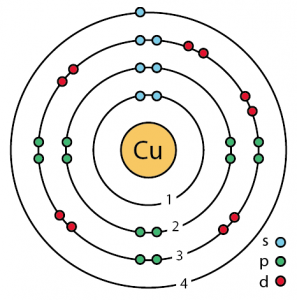
Copper Electron Configuration (Bohr Model)
Uses of Copper
- Commonly used for making coins [1].
- For electrical equipment such as motors and wiring due to its high electrical and thermal conductivity [1].
- For construction purposes (like plumbing and roofing) and industrial machinery (like heat exchangers) [1].
- Copper sulfate finds wide application as an agricultural poison and algaecide in water purification [1].
- Copper compounds, for example, Fehling’s solution, are used in chemical tests that detect sugar [1].
Is It Dangerous
Though the element is essential to all plants and animals, excess amounts are toxic. Cooking acidic food in copper utensils can cause poisoning. That is why copper cookware should be lined to prevent the ingestion of dangerous verdigris (compounds formed by copper corrosion). An adult human being needs around 1.2 milligrams of copper daily [1, 3]. You can prevent copper deficiency by taking foods high in copper such as whole grains, nuts, beans, potatoes, oysters and other shellfish [22].
Interesting Facts
- Unlike human beings that use the iron present in blood hemoglobin to transfer oxygen in their bodies, some crustaceans use copper complexes [1].
- The surface of copper, when left exposed to air, gradually tarnishes to a dull, brownish color [3].
Cost of Copper (Cu Element)
The pure metal is priced at $9.76 for every 100 gram and in bulk, the same quantity is worth $0.66 [3].
- References
- http://www.rsc.org/periodic-table/element/29/copper
- https://education.jlab.org/itselemental/ele029.html
- https://www.chemicool.com/elements/copper.html
- https://www.lenntech.com/periodic/elements/cu.htm
- https://environmentalchemistry.com/yogi/periodic/Cu.html
- https://www.enotes.com/homework-help/valency-copper-585843
- http://chemistry-reference.com/q_elements.asp?Symbol=Cu
- http://hyperphysics.phy-astr.gsu.edu/hbase/Tables/thrcn.html
- https://www.thoughtco.com/table-of-electrical-resistivity-conductivity-608499
- http://www.iun.edu/~cpanhd/C101webnotes/matter-and-energy/specificheat.html
- https://www.engineeringtoolbox.com/specific-gravity-solids-metals-d_293.html
- https://www.electronics-tutorials.ws/resistor/resistivity.html
- http://periodictable.com/Properties/A/MohsHardness.v.html
- https://kupfer.de/kupferwerkstoffe/kupfer/eigenschaften/?lang=en
- https://www.cirris.com/learning-center/general-testing/special-topics/177-temperature-coefficient-of-copper
- http://hyperphysics.phy-astr.gsu.edu/hbase/Tables/thexp.html
- nj.gov
- https://www.quora.com/Is-copper-magnetic
- http://periodictable.com/Properties/A/LatticeConstants.html
- https://www.webqc.org/molecular-weight-of-Cu.html
- https://www.webelements.com/copper/chemistry.html
- https://medlineplus.gov/ency/article/002419.htm
